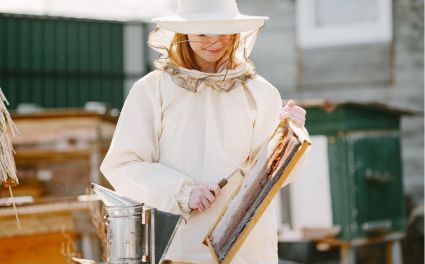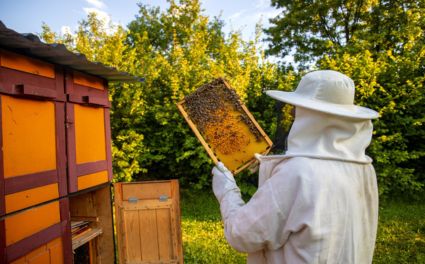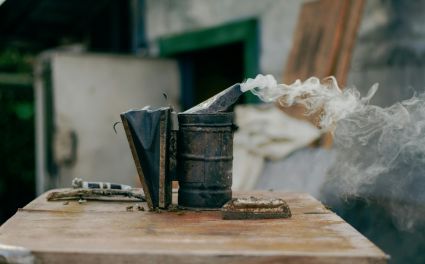Bee colonies are among nature’s most fascinating examples of social organization. Within a single hive, thousands of honey bees work together in perfect coordination, each fulfilling specialized roles that ensure the survival and prosperity of the entire colony. From the queen bee’s reproductive duties to the workers’ tireless labor and the drones’ brief yet crucial purpose, every member plays an important role. Understanding how bee colonies function helps both new and experienced beekeepers strengthen their hives and appreciate the intelligence of these incredible insects.
🐝 Structure of a Bee Colony
A healthy bee colony is made up of three primary castes — queen bee, worker bees, and drone bees. Each type contributes to the smooth operation of the hive.
👑 Queen Bee
The queen bee is the heart of the colony and its only fertile female. Her primary role is egg-laying, producing up to 2,000 eggs per day during peak season. She develops in a special cell and is fed exclusively on royal jelly, which allows her to mature into a fertile queen.
Physically, she is larger than other bees with a long abdomen and smooth stinger. Her pheromones regulate the colony’s behavior, suppressing other females from laying eggs and maintaining social harmony.
When beekeepers inspect hives, they often wear beekeeping veils to safely locate and identify the queen during routine checks.
Also read: How Does a Bee Become Queen?
👷 Worker Bees
Worker bees are all female but sterile. They make up the majority of the hive and are the true workforce behind every successful colony. Their responsibilities evolve with age:
-
Young workers care for brood (baby bees) and feed the queen.
-
Middle-aged workers build comb, regulate hive temperature, and guard the entrance.
-
Older workers become foragers, collecting nectar, pollen, water, and propolis.
These tasks are performed tirelessly throughout the worker’s short lifespan of 4–6 weeks in summer. Winter workers, however, live longer as they conserve energy and cluster to keep the colony warm.
Comfort and mobility are vital during inspections, which is why many beekeepers prefer beekeeping suits with proper ventilation to stay sting-free while checking worker activity.
♂️ Drone Bees
Drone bees are the males of the colony. Their primary purpose is reproduction — to mate with virgin queens from other hives. They lack stingers and do not participate in collecting food or hive maintenance.
Drones are produced in spring and summer when nectar is abundant. As autumn approaches, worker bees often eject them from the hive to conserve food resources.

🏠 Hive Organization
A bee colony’s structure extends beyond its members — it includes the beehive, a highly efficient natural or man-made structure made of wax combs. Beeswax, secreted from glands on worker bees’ abdomens, forms the building blocks of the hive.
Brood Chambers and Honey Supers
The brood chamber is the hive’s nursery, where the queen lays eggs and young bees are raised. Worker bees maintain a stable temperature of around 35°C for healthy brood development.
Above the brood area are the honey supers, where surplus honey is stored. Beekeepers harvest honey from these sections without disturbing the brood. Proper beekeeping jackets help protect keepers during this delicate process.
Storage and Environmental Control
Bees store honey, pollen, and nectar in perfectly shaped hexagonal comb cells. Honey is capped with beeswax once it reaches the ideal moisture level, while pollen serves as the colony’s protein source.
Temperature control is critical — bees fan their wings to cool the hive and cluster together to generate warmth during cold months. Beeswax comb also insulates the hive, helping it stay stable year-round.
Tools and Accessories
For efficient hive management, using proper beekeeping equipments such as smokers, brushes, and hive tools ensures smooth handling of frames without disturbing bees unnecessarily.
🐝 Communication and Cooperation
Communication within a bee colony is remarkably advanced. Bees rely on pheromones and physical dances to coordinate tasks and share information.
The Waggle Dance
Discovered by Nobel Prize–winning scientist Karl von Frisch, the waggle dance is how foragers communicate food source locations to other bees. The angle and duration of the dance indicate both direction and distance from the hive.
This efficient communication system allows colonies to exploit food sources quickly, maximizing honey production.
Pheromones
Bees use pheromones as chemical signals for colony coordination. The queen’s pheromones maintain unity, while alarm pheromones alert workers to danger. Nurse bees also release pheromones to help larvae grow.
Protective wear such as beekeeping gloves ensures that beekeepers can inspect these delicate interactions safely.
Division of Labor
Each bee has a clearly defined role. This division of labor ensures that every task — from building comb to guarding the hive — is performed efficiently. Such cooperation mirrors a miniature society, demonstrating how unity ensures survival.
Collective Decision-Making
When the colony must relocate or swarm, scouts explore new nest sites. They return to the hive to “advertise” their discoveries through dances. After comparing the dances, the bees reach a collective consensus, selecting the best location.
This natural democracy highlights how thousands of bees cooperate harmoniously without conflict — a model that has even inspired modern algorithms in computer science and robotics.
🌸 Seasonal Patterns of a Bee Colony
Understanding seasonal rhythms is essential for effective beekeeping. Each season demands different strategies from the bees — and their keepers.
Spring: Buildup and Expansion
Spring signals renewal. The queen ramps up egg-laying, and worker bees forage vigorously. Colonies expand rapidly, and beekeepers must add additional frames or honey supers to prevent swarming.
During this time, protective wear like beekeeping trousers ensures comfort during long hours of hive inspection.
Summer: Honey Production Peak
Summer is when colonies reach full strength. Foragers collect nectar, converting it into honey through evaporation and enzymatic activity. Proper ventilation and pest management are vital to maintain hive health.
This is also when beekeepers harvest honey, always leaving enough stores for the bees’ survival. Wearing beekeeping ankle protection keeps your lower legs secure while working near ground hives.
Also read: Difference Between a Beehive and a Wasp Nest
Autumn: Preparation for Winter
As flowers fade, colonies reduce brood production and focus on storing honey. Worker bees evict drones to preserve food supplies. Beekeepers assist by ensuring hives are insulated and that sufficient honey remains for winter.
Winter: Survival and Rest
During winter, bees cluster tightly to maintain warmth. They consume stored honey as fuel, vibrating their flight muscles to generate heat. Winter survival depends heavily on the health and preparation achieved during previous seasons.
🐝 Importance for Beekeepers
Understanding how bee colonies function helps beekeepers predict behavior, improve honey yield, and maintain healthy hives. Wearing protective gear like beekeeping kids suits ensures safety for families exploring beekeeping together.
Experienced apiarists often emphasize the balance between protection and comfort. Quality pink bee suits are also available for those who prefer stylish yet functional gear — explore the range here.
Curious about gear performance? Read Do Bee Suits Protect from Wasps?

🌼 Final Thoughts
Bee colonies are living examples of cooperation and precision. Every drone, worker, and queen plays an indispensable part in ensuring the hive’s balance and survival.
For beekeepers, understanding colony dynamics is key to responsible hive management — from seasonal preparation to honey harvesting. By using proper tools and protective clothing from trusted brands like Oz Armour, beekeepers can interact safely with their honey bees, contribute to pollination, and sustain healthy ecosystems.
To deepen your understanding, explore Learn Beekeeping or discover fascinating insights in The Secret Lives of Bees and How to Safely Remove a Bee Sting.
The next time you observe a hive in action, remember: behind that buzzing harmony lies an extraordinary system built on teamwork, adaptability, and communication — the essence of nature’s perfect balance.




